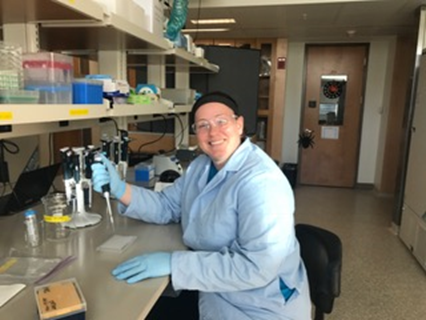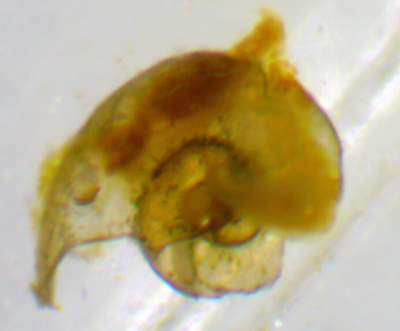By: Tanya Traeger

The author (Tanya Traeger) processing samples for DNA barcoding at SERC. Image courtesy of Tanya Traeger.
The holidays have arrived, signaling an end to my last full-time semester at GMU!
To provide some background, I am studying to be a veterinarian and wanted to gain experience in research. The biology department at GMU offers a research semester every fall for students such as myself looking to explore their future. This is how I happened upon Kim and the rest of her fish heads!
For those of you who may not know, GMU has been actively working with Fairfax County for 30 years in efforts to improve water quality of Gunston Cove, a tributary to the Potomac River. Dramatic decreases in both nitrogen and phosphorus have led to increased water clarity. This change has caused a transition from a phytoplankton dominated habitat to that of submerged aquatic vegetation (SAV).
Each summer, fish are collected, measured, and sorted by habitat to note any changes in the community structure. This year specifically, Casey Pehrson, one of Kim’s graduate students, was working on diet study of the fish at Gunston Cove. Kim partnered me with her over the summer. We took a total of three days out on the water collecting fish and recording them as has been done over the years. We kept any fish over 50 mm and euthanized them for further analysis of their stomach content.
Back at the lab, stomachs were removed and dissected. Prey items were sorted and classified to the lowest taxonomic level. Each prey item was then frozen in sterile wells for further analysis using DNA barcoding – which I will discuss in further detail.

Image of a snail shell taken with the microscope camera. Image courtesy of Tanya Traeger.
Because the amplification of the DNA and barcoding process is a time-consuming process, data analysis was conducted on the taxonomic data. Using Primer-E, software specifically designed for ecologist, the prey items were analyzed by fish species and habitat type. Two species were used in this part of the analysis: the pumpkinseed fish and the bluegill fish. Submerged aquatic vegetation (SAV), open water, and the littoral zone were the assessed habitat types. The results found that while there was both a significant difference in prey items between the species, there was an even greater difference between habitat.
Additionally, fish community data from 1999 was pulled from the Potomac Environmental Research and Education Center (PEREC). Comparing this data to the community data from 2016, a significant shift was observed in the community structure. Because diet data was not available from the 1999 fish community, the open water habitat was used as a proxy to represent the fish diet for that year while the SAV habitat was used to represent the fish diet for 2016. Given that significant differences were found between habitats, it can be concluded that the fish who use the SAV habitat for prey items will likely continue to thrive, while those fish who prefer the open water may decrease in number. A great example of this can be found with the decrease in the Golden Shiner. Its numbers decreased by more than 50% between 1999 and 2016. This can likely be attributed to the fact that plankton is one of the Golden Shiner’s top prey items. While there is still plankton in the cove, the number has dramatically decreased since the shift to SAV dominance.
As mentioned before, prey items were frozen for further analysis using DNA barcoding. This method involves amplifying DNA from each prey item and, through a series of many steps, producing a genomic sequence for each item. The results for these fish are still pending, but this will provide a more complete picture of the fish diets as many items will be able to be classified to the species level. This is being accomplished through collaboration with the Smithsonian Environmental Research Center (SERC) in Edgewater, MD. I have spent a handful of days out their working with a few of their scientists. It involves a lot of patience and pipetting! I must say that my thumbs are feeling very strong!
All in all, I would have to say that this has been a fun experience for me – especially the days out on the boat! Of course, the field work is the most fun, but I have also been introduced to a side of ecology that I did not know much about. It was also great to get a good understanding for the amount of time and thought that goes into research. It is a field that requires patience and attention to detail. Lots of planning goes into the way that methods are to be carried out prior to jumping into things. Possibly the most important lesson of all that I learned from this experience is that often your research will depend on what data you can collect. For instance, with this project we were originally hoping to compare the fish diet of the native catfish to the non-native, invasive blue catfish. However, after three days on the boat we were unable to collect any native catfish and only collected a small number of blue catfish. Therefore, our research direction had to shift. At least in similar studies, you will always be at the mercy of the organism you are collecting!
I would specifically like to thank Kim for this great opportunity and providing lots of direction as this was my first experience working with fish and I frequently felt a little lost! Also, a huge thank you to Casey for assisting with the dissections, field work, accompanying me to SERC, and pretty much everything else!